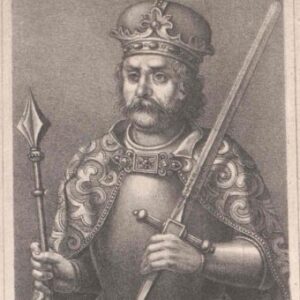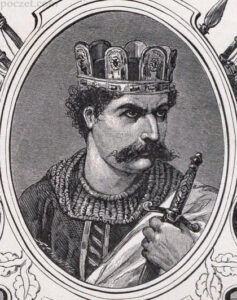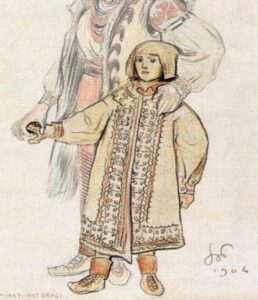In 1088, just one year before his tragic death, Prince Mieszko Bolesławowic stood at the altar. His chosen bride was a mysterious Russian princess whose identity continues to spark debates among historians to this day. Was she the daughter of a powerful Kievan prince, or perhaps the sister of the warlike Rostislavichi?
The Marriage of Mieszko Bolesławowic
One year before his death (1088) Mieszko Bolesławowic entered into marriage. This fact was recorded in many Polish annals. The prince’s marriage was also written about in his chronicle by Gallus Anonymus, which allows us to consider the information about Mieszko’s celibacy contained in the „Greater Poland Chronicle” written in the late Middle Ages, as completely erroneous. The anonymous Greater Poland chronicler either had inaccurate data or – equally likely – misinterpreted the accounts of his predecessors, with Gallus Anonymus at the forefront. The author of the „New Holy Cross Annals” probably did the same, mentioning two marriages of Bolesław the Generous’s son. However, contemporary written sources did not mention this, which naturally makes such information unreliable.
From the chronicle left by the Gallus Anonymous, it clearly emerges that Mieszko Bolesławowic’s marriage was arranged by his uncle Władysław Herman, who chose an appropriate partner for him. This mention is significant because the chronicler thus made it understood that Władysław recognized his nephew as something more than a ward. In the text we read that King Władysław of Hungary treated Mieszko „like a son”, yet did not give him a wife. If, therefore, Herman on his own initiative brought about Mieszko’s wedding, it means that his relations with his nephew were good.
It can be assumed that Władysław Herman was heavily involved in organizing the wedding ceremony for his nephew. Certainly Mieszko himself also tried to make this ceremony turn out as well as possible. It is not inconceivable that the young couple’s wedding took place in Cracow (if that was where Mieszko’s seat was located) or in Płock, that is, in the stronghold serving as the capital, where Herman stayed most willingly and frequently. Due to lack of sources, it is difficult to determine who was invited to Mieszko’s wedding. The majority of guests were certainly Poles, but it is also impossible to exclude the participation of visitors from abroad, specifically from Rus’, from where – as the sources recorded – the bride originated.
See also: Wife of Mieszko the Old – the Mysterious Princess
The Russian princess’s happiness at the side of her Piast husband lasted an extremely short time. As genealogists have established, Mieszko died unexpectedly no later than early January 1089, which must have been a painful blow for the woman who had appeared in the land along the Vistula not so long ago. A different version of events was presented several centuries later by Jan Długosz, writing about the simultaneous death of the Russian princess along with her husband after consuming poison. However, this version does not agree with the account of Gallus Anonymus, who was contemporary to the events and knew only about Mieszko’s poisoning.
It is therefore possible that the prince’s wife died at a later date. This does not mean, however, that it happened in 1103, as Długosz wanted. This date contradicts the chronology of events presented by Polish annals, which recorded noteworthy events as they occurred. Today we already know that the 15th-century canon, killing Mieszko and his wife at the beginning of the 12th century, made a glaring error because he considered authentic a founding document of the monastery in Mogilno, issued by some Mieszko in Kruszwica in 1110. For the historian, there was no doubt that the issuer of the document was the son of Bolesław the Generous. In reality, this document was a forgery made in the name of Mieszko III the Old. However, the forger made an error in the document’s date by one hundred years – instead of the year 1200, he wrote 1100. Długosz did not know that he was dealing with an incorrectly dated forgery, which he erroneously connected with the person of Mieszko Bolesławowic.

The Origin of the Prince’s Wife
Contemporary written sources about Mieszko Bolesławowic (led by Gallus Anonymus’s „Polish Chronicle”) provided no details regarding the origin of his spouse. Only Jan Długosz mentioned that Mieszko became involved with Eudoxia, sister of Prince Sviatopolk, son of Iziaslav. This marriage – according to the chronicler – was supposed to guarantee the loyalty of the Russians, who had been subordinated to Poland during Bolesław the Generous’s lifetime.
Many historians believed in the filiation of Mieszko’s wife given by Długosz. However, from the times of Marcin Kromer (1512–1589) onward, people began to doubt the truthfulness of the Cracow canon’s account and introduced certain modifications to it. It was believed that Eudoxia could have been at most Sviatopolk’s daughter, or possibly the daughter of Rostislav of Tmutarakan. As O. Balzer demonstrated in his „Genealogy of the Piasts” at the end of the 19th century, all these assumptions are erroneous because Jan Długosz made an error in dating Sviatopolk’s reign, which caused the identification of Mieszko Bolesławowic with Mieszko III the Old, who married Eudoxia (mid-12th century). Moreover, as J. Tęgowski recently correctly stated, in the case of Mieszko Bolesławowic marrying Sviatopolk’s sister, the young couple would first have to seek papal dispensation due to their too-close kinship (common grandfather – Mieszko II).
The Russian researcher A.V. Nazarenko apparently did not familiarize himself with the observations of Polish historians, according to whom Mieszko Bolesławowic took as his wife one of Sviatopolk’s daughters (the prince of Turov-Novgorod). The initiator of this marriage was supposed to be Władysław Herman, seeking a counterweight to the German-Czech-Russian (Kievan) bloc that emerged in 1085–1086. By marrying Mieszko to Sviatopolk’s daughter, Władysław wanted to neutralize the actions of Grand Prince Vsevolod of Kiev, whose daughter Praxedes was planned to be married to Saxon Margrave Henry of Stade (1089). According to Nazarenko, Hungary under Władysław the Saint also joined the alliance of Poland with the Turov-Novgorod principality, whose daughter married Yaroslav, Sviatopolk’s son, no later than 1091.

Revolutionary Ideas
Even if one agrees with A. Nazarenko’s concept, it should be noted that the political constellation created after Mieszko Bolesławowic’s marriage quickly passed into history due to the death of the Piast prince and the Polish-German rapprochement, which found expression in the union of Emperor Henry IV’s sister with Władysław Herman (ca. 1089). Nazarenko’s hypothesis is based on relatively fragile source foundations. From available written sources, it only emerges that in the mid-1080s, Germany and Bohemia had friendly relations, and Vratislav II supported Henry IV in various ways. However, nothing is known about any animosities on the Poland-Germany line. In reality, Władysław Herman was too weak to harm or threaten the powerful Henry in any way, who was at that time one of the strongest European rulers.
When considering Nazarenko’s idea, it should also be noted that on the eve of Mieszko Bolesławowic’s marriage to Sviatopolk’s daughter, there were practically no reasons for hostility to arise between Władysław Herman and the Grand Prince of Kiev. Relations between both rulers must have improved after Prince Yaropolk Iziaslavich, who was in conflict with Sviatopolk, died in 1087. The assumption that Herman complicated his international situation by entering into an alliance with one of the Russian principalities seems unlikely, especially since the circumstances of Sviatopolk’s daughter’s marriage to German Margrave Henry of Stade are not known. It is difficult to judge whether this was a typically political act directed against the Piast state, or a union of two people connected by true love, as some historians from across the Oder believe.
See also: Anastasia – Wife of the Unfortunate Piast Prince
Recently, the opinion has prevailed in Polish historiography that Mieszko Bolesławowic’s wedding was connected with the activities of the Rostislavichi, sons of Rostislav Vladimirovich: Rurik, Volodar, and Vasilko. These princes, thanks to increased activity on the Polish-Russian border, managed to capture Przemyśl, which had remained with the Piasts until then, and establish an independent principality there. Power was first assumed by the eldest, Rurik, and then, after his death (1091), by the middle brother Volodar. The neighborhood of the Rostislavichi must have been particularly troublesome for Mieszko, assuming he resided in Cracow or in – as proposed some time ago – Sandomierz as the easternmost Piast stronghold.
According to experts on the subject, the individual actions of Rurik and his brothers, allied with the Cumans and the pretender to the Hungarian throne Solomon, were also not to the liking of King Władysław the Saint, who sought to maintain peace in border areas and retain power in Buda. All this created – as was argued – favorable conditions for Hungarian-Polish rapprochement, whose guarantor, due to friendly relations with the Árpáds, would be Mieszko Bolesławowic. Władysław Herman, interested in weakening the Rostislavichi’s influence in the region, was most likely also included in this alliance. Consequently, it was agreed to marry Mieszko to the sister of the warlike brothers, which influenced the cessation of the Rostislavichi’s expansive policy toward Hungary and Poland.
The theory presented above seems very convincing at first glance. It is therefore not surprising that many historians accepted it without major doubts. K. Benyskiewicz acted differently, who believed that Mieszko Bolesławowic’s marriage to Rostislav’s daughter could not have taken place because the Russian prince had no daughters! This observation – which goes without saying – excludes the possibility of an alliance between the Piasts and the Rostislavichi.

Catherine Vsevolodovna as Mieszko’s Wife?
Thanks to the concept put forward by the aforementioned K. Benyskiewicz, another hypothesis gained likelihood, identifying Mieszko Bolesławowic’s wife with one of the daughters of Grand Prince Vsevolod Yaroslavich of Kiev. This marriage – according to the scholar – was extremely desirable for the Polish side due to the alliance connecting Vsevolod with Hungary, which provided them with allies in one stroke in the fight against the ambitious Rostislavichi. This marriage was also beneficial for Mieszko himself, because he gained, alongside Władysław the Saint, a new partner and simultaneously (due to his position in Kievan Rus’) a powerful ally.
Vsevolod had at least three daughters: Yanka, Catherine, and a third, unknown by name. Which of them could have become the wife of Bolesław the Generous’s son? It was most likely not Yanka, who died in 1112 and became a nun at a young age. Russian chronicles contain no information that she ever entered into marriage. Mieszko Bolesławowic’s spouse could also not have been Vsevolod’s daughter unknown by name, about whom we only know that she died in 1089. In scholarship, the opinion has recently prevailed to remove this woman from the list of Rurikovichi, because she may have appeared on it as a product of the chroniclers’ imagination.
See also: Who was Dobroniega Maria, the wife of Casimir the Restorer?
The most suitable candidate for Mieszko’s wife therefore remains Catherine Vsevolodovna. According to genealogists, she lived almost forty years, was born around 1070, and died – as carefully noted in sources – on July 11, 1108. Catherine’s mother was Anna, daughter of a Cuman khan. The woman never found herself behind monastery walls, which would suggest that she married. Although we will not find mention of her marriage in the chronicles, these accounts did not always precisely record Rurikovichi marriages. In 1088, Catherine was of an age predestining her for marriage and could have wed the Polish prince. When her husband died a year later, the widow – according to the custom prevailing at that time – most likely returned to her native lands.
Bibliography
-Balzer O., Genealogia Piastów, wstęp J. Tęgowski, Kraków 2005.
-Benyskiewicz K., Mieszko Bolesławowic (1069–1089). Źródła i tradycja historiograficzna, Kraków 2005.
-Benyskiewicz K., Piastowie i Rurykowice. Polsko-ruskie stosunki polityczne od X do połowy XII wieku, Zielona Góra 2020.
-Delestowicz N., Mieszko Bolesławowic, [w:] idem, Bolesław II Szczodry. Trzeci król Polski. Od władzy po wygnanie, Kraków 2020.
-Jasiński K., Rodowód pierwszych Piastów, posł. T. Jurek, Poznań 2004.
-Krawiec A., Król bez korony. Władysław I Herman książę Polski, Warszawa 2014.
-Kuczyński S.M., Stosunki polsko-ruskie do schyłku wieku XII, [w:] idem, Studia z dziejów Europy Wschodniej X–XVII w., Warszawa 1965.
-Powierski J., Kryzys rządów Bolesława Śmiałego. Polityka i jej odzwierciedlenie w literaturze średniowiecznej, Gdańsk 1992.
-Skibiński E., Przemiany władzy. Narracyjna koncepcja Anonima tzw. Galla i jej podstawy, Poznań 2009.
-Teterycz-Puzio A., Zamachy na Piastów, Poznań 2019.
-Trawkowski S., Władysław I Herman, [w:] Poczet królów i książąt polskich, red. A. Garlicki, Warszawa 1978.
-Tęgowski J., Kontakty rodzinne dynastów polskich i ruskich w średniowieczu, [w:] Między sobą. Szkice historyczne polsko-ukraińskie, red. T. Chynczewska-Hennel, N. Jakowenko, Lublin 2000.
Author: Alicja Samp